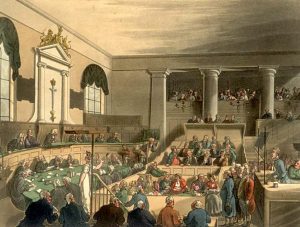History of Criminal Law
 The Sumerian people from what is now Iraq produced the earliest known example of a written set of criminal laws. Their code, created around 2100-2050 BC, was the first to create a distinction between criminal and civil wrongdoings. Civil law governs disputes between two or more private parties (modern examples include contract disagreements and divorce proceedings), while criminal law covers cases initiated by the state or federal government against an individual that has harmed another person or the general public in some way.
The Sumerian people from what is now Iraq produced the earliest known example of a written set of criminal laws. Their code, created around 2100-2050 BC, was the first to create a distinction between criminal and civil wrongdoings. Civil law governs disputes between two or more private parties (modern examples include contract disagreements and divorce proceedings), while criminal law covers cases initiated by the state or federal government against an individual that has harmed another person or the general public in some way.
In Europe, one of the earliest documents that highlights criminal law emerged after 1066 when William the Conqueror, the Duke of Normandy, invaded England. By the 18th century, European law began to specifically address criminal activity and the concept of trying criminals in a court room setting began to develop. The English government created a system known as common law, which is the process that establishes and updates rules that govern a group of people. Common law covers both civil and criminal matters, and works through the creation and continual revision and expansion of laws by judges as they make rulings on legal matters. These rulings become precedents to help determine the outcomes of future cases.
Following the voyage of Christopher Columbus in 1492, Europe began to establish colonies in the Americas. British Common Law regulated the developing North America until the outbreak of the American Revolution. By the end of the war, America had become an independent nation, and adopted the United States Constitution. The Constitution, known as the “supreme law of the land” and officially ratified in 1789, established the judicial branch of the government. The judiciary borrowed from the English tradition and initiated a common law system which creates and revises the rules that govern the country today.
In modern times, the U.S. system of common laws continues to define what is and is not a crime, and the severity of any offense. Criminal cases brought before the courts are generally separated into three categories: misdemeanors, felonies, and treason. Misdemeanors are lesser offenses settled with fines or forfeiture of property, and some are punishable with a jail sentence of less than one year. Felonies are far more serious crimes that result in harsher penalties such as being sentenced to a state or federal penitentiary for one year or longer. They include assault cases, drug sales, various white collar crimes and other deeds that are harmful to people or society. Felony crimes such as homicide may also be eligible to receive the death penalty in some states. Treason is defined as any act that violates allegiance to your own country. Originally this primarily referred to war crimes, but over the years the most common form of treason has become the selling of government secrets to hostile countries.
Criminal law continually grows, and is often subject to change based on the morals and values of the times. The basic purpose of these laws has always been to bring justice to those who have intentionally caused harm to others and to protect the citizens of every country.

